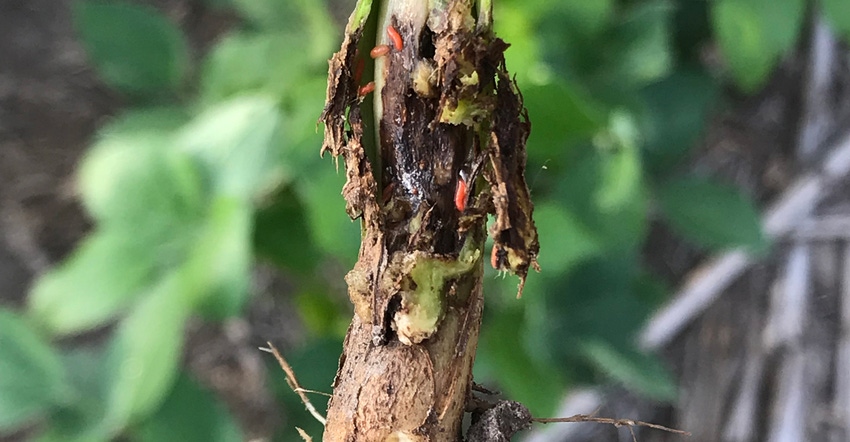
With reports of orange larvae in soybean fields the last two years, followed by dead soybean plants, growers in eastern Nebraska dealing with soybean gall midge may be asking: Now what?
This year, University of Nebraska researchers began tracking the pest’s emergence patterns — starting with the overwintering generation from 2018 and continuing with the first generation of 2019 — to gain a better understanding of the gall midge, which was identified as a new species earlier this year. As of mid-July, it had been confirmed in 27 Nebraska counties, four more than 2018.
In some cases, growers are dealing with 40% to 50% infested fields in the first 200 feet of their field — which means a lot of wilted and dead plants, notes Justin McMechan, Nebraska Extension crop protection and cropping systems specialist.
“It makes you wonder: Did they spray something at the end of the field? Was it a chemical application? But you break the plants open, and there’s plenty of larvae,” McMechan says.
At times, this has resulted in complete yield losses at field edges. With lower losses, it’s up to 20% farther into the field.
Soybean gall midges, feeding
Soybean gall midge is identifiable by orange larvae that hatch from eggs laid on the outside of the soybean plant. The larvae then feed on the stem, killing the plant. Without understanding the insect’s emergence patterns, it’s impossible to know what insecticides will provide adequate control.
Based on other gall midge species in the same genus, it’s assumed adults do not feed on soybean plants —only larvae do. However, larvae are typically found on the insides of stems, so an insecticide would have to systemically kill larvae or target adults moving into the field. Other species in the genus are parthenogenetic, having the ability to reproduce asexually.
McMechan and other researchers are using cage traps in fields to determine emergence patterns and life spans of different generations in eastern Nebraska counties. He’s also using time-lapse cameras to try to visually document infestations to determine how long they typically last, and plant response following an infestation.
The overwintering generation from last year emerged for about 24 days from some sites this spring, with adult populations ranging from two to almost 100 per site as of mid-July. Now, McMechan and others are monitoring emergence of the first generation from this year.
“That tells us we have adult emergence and presence over a 24-day period. They’re continually laying eggs in those plants,” McMechan says. “What this means for the first true generation from 2019: We’re likely to see emergence all the way into mid-August, because their emergence window will likely get wider rather than narrower with each generation in the season.”
For soybeans planted late — after June 1 — first-generation gall midge pressure might be significant, depending on landscape and history in the area. McMechan notes an insecticide application around V3 may be warranted for growers with late-planted soybeans under significant pressure. However, for those with injury from the overwintering generation, it’s probably too late for any control measures.
“We really don't have anything on the market that can stretch that long. The best we have is seven to 10 days. Some growers have lobbed on an insecticide every seven days, as the label allowed,” he says.
2019 research trials on 5 dates
In trials conducted this year, Nebraska researchers planted soybeans at five different dates —and all showed different levels of infestation from overwintering generations. As of mid-July, soybeans planted on May 1 were 45% infested, compared to 47% for May 15, before dropping off to 3% for June 1, and then 0% for June 15 and July 1. While the newly emerged first generation is likely to have an effect on later planting dates, those differences may not be very significant at the end of the season.
“Once the plants reach V3, in Nebraska, the stems appear to form cracks at the soil surface, likely as a result of stem expansion with growth. That’s where those midges are laying eggs,” McMechan adds. “Prior to that, at V2 and V1, they’re nice, clean plants, so there’s really no way for the midges to enter. That’s what’s driving the difference for those planting dates. All those earlier planting dates are well into their plant development stages.”
McMechan says there will likely be at least two generations a year, followed by a partial third that will either be killed by an early frost or survive on later-maturing soybean plants. This year, the first two generations briefly overlapped.
"They've really stretched themselves out to make sure they have overwintering larvae over a wide range of the season. They’re not going to fall off the map by accident,” he says.
Research is underway to identify potential alternative hosts to determine whether the gall midges came from any other plants, and how far they can travel. In addition, McMechan hopes to determine thresholds the larvae need to reach to kill the plant — and whether larval counts can at least be dropped below that threshold, if not eliminated entirely.
"There are some questions that will take five to 10 years to answer confidently,” McMechan says. “We learned a lot of things this spring, and my hope is to at least get a Band-Aid on this to fight for longer-term control tactics for growers under significant pressure. The benefit is, we can really find answers now. The sad part is, growers need to wait while we figure it out.”
About the Author(s)
You May Also Like






